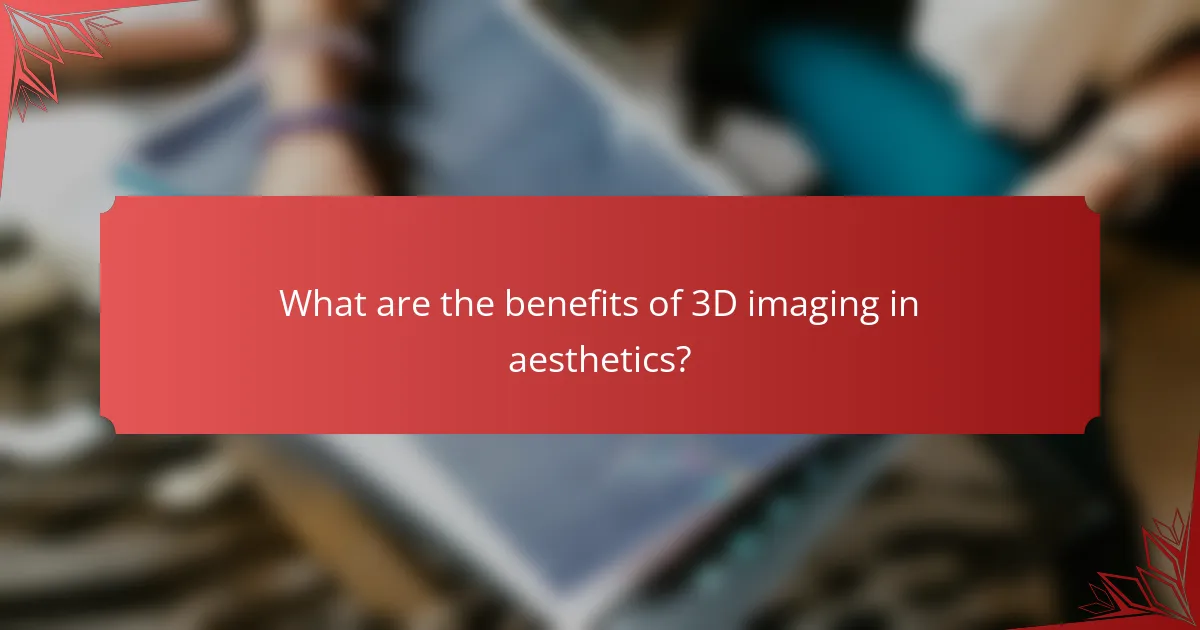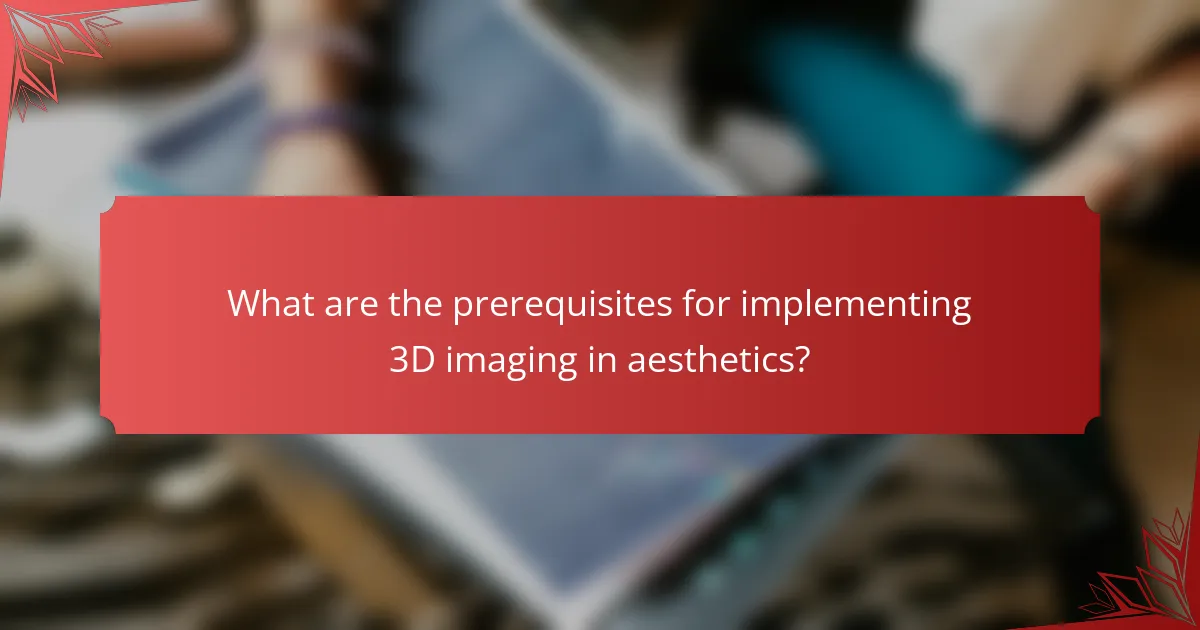3D imaging is revolutionizing the field of aesthetics by providing detailed visualizations that enhance both planning and communication between practitioners and clients. This innovative technology not only allows for accurate representations of potential outcomes but also significantly improves patient understanding and satisfaction, leading to more informed decision-making and personalized treatment experiences.

How is 3D imaging used in aesthetic procedures in South Africa?
3D imaging is increasingly utilized in aesthetic procedures across South Africa, providing detailed visualizations that enhance planning and client communication. This technology allows practitioners to create accurate representations of potential outcomes, improving both the client experience and procedural precision.
Facial reconstruction
In facial reconstruction, 3D imaging helps surgeons visualize the anatomy of the face before performing procedures. This technology enables precise mapping of facial features, allowing for tailored approaches that enhance symmetry and aesthetics.
Practitioners can simulate various outcomes, helping clients understand the potential results of their procedures. This clarity can significantly influence decision-making and satisfaction with the final results.
Body contouring
For body contouring, 3D imaging assists in visualizing the body’s shape and proportions, enabling more accurate treatment plans. Surgeons can assess areas needing enhancement or reduction, ensuring a balanced and natural appearance post-procedure.
Clients benefit from seeing potential results through simulations, which can help set realistic expectations. This process often leads to higher satisfaction rates as clients feel more involved in their aesthetic journey.
Dental aesthetics
In dental aesthetics, 3D imaging is used to create detailed models of a patient’s teeth and gums. This technology allows dentists to plan procedures like veneers, crowns, or orthodontics with precision, ensuring a perfect fit and alignment.
Clients can visualize their new smiles through digital simulations, which can enhance their confidence in the proposed treatments. This approach also minimizes the risk of errors during the actual procedures.
Skin analysis
3D imaging plays a vital role in skin analysis by providing a comprehensive view of the skin’s texture and condition. Practitioners can identify issues such as wrinkles, pigmentation, and other irregularities that may not be visible to the naked eye.
This detailed analysis allows for personalized treatment plans, ensuring that clients receive the most effective interventions for their specific skin concerns. Regular skin assessments using 3D imaging can track progress over time, enhancing client satisfaction.
Surgical planning
In surgical planning, 3D imaging offers a clear view of the anatomy involved, allowing surgeons to strategize their approach effectively. This technology aids in anticipating challenges and optimizing techniques for better outcomes.
By providing a visual reference, 3D imaging enhances communication between the surgeon and the client, ensuring that both parties have aligned expectations. This can lead to improved trust and satisfaction with the surgical process.

What are the benefits of 3D imaging in aesthetics?
3D imaging in aesthetics offers significant advantages, including enhanced visualization, improved patient communication, accurate treatment planning, reduced surgical risks, and personalized outcomes. These benefits contribute to a more effective and satisfying experience for both practitioners and clients.
Enhanced visualization
3D imaging allows practitioners to create detailed and realistic representations of a patient’s anatomy. This technology enables both doctors and patients to visualize potential results before any procedures are performed, leading to better understanding and expectations.
For example, a 3D model can illustrate how facial fillers will enhance features, helping clients make informed decisions. This clarity can significantly reduce anxiety related to the unknown outcomes of aesthetic procedures.
Improved patient communication
Effective communication is crucial in aesthetic treatments, and 3D imaging facilitates this by providing a common visual reference. Practitioners can explain procedures and expected results more clearly, ensuring that clients fully understand their options.
Using 3D images, practitioners can address specific concerns and preferences, leading to a more collaborative approach. This transparency fosters trust and helps align patient expectations with realistic outcomes.
Accurate treatment planning
3D imaging enhances treatment planning by allowing for precise measurements and assessments of a patient’s unique anatomy. This accuracy helps practitioners devise tailored strategies that consider individual features and desired results.
With detailed visual data, aesthetic professionals can simulate various treatment scenarios, optimizing their approach. This reduces the likelihood of errors and enhances the overall effectiveness of the procedures.
Reduced surgical risks
By utilizing 3D imaging, practitioners can identify potential complications before they arise, thereby minimizing surgical risks. The detailed visualizations help in planning incisions and understanding anatomical structures, which is particularly important in complex procedures.
For instance, knowing the exact location of nerves and blood vessels can prevent damage during surgery, leading to safer outcomes. This proactive approach not only protects patients but also enhances the practitioner’s confidence in their techniques.
Personalized outcomes
3D imaging supports the creation of personalized treatment plans that cater to the unique needs and desires of each patient. By visualizing different options, clients can choose the approach that best aligns with their aesthetic goals.
This level of customization improves satisfaction rates, as patients are more likely to achieve results that reflect their individual preferences. Personalized outcomes contribute to a more positive overall experience in aesthetic treatments.

How do clients perceive 3D imaging in aesthetic treatments?
Clients generally view 3D imaging in aesthetic treatments as a valuable tool that enhances their understanding of potential outcomes. This technology allows clients to visualize results before undergoing procedures, which can significantly influence their satisfaction and decision-making process.
Increased confidence
3D imaging boosts client confidence by providing a realistic preview of expected results. When clients can see a visual representation of their potential transformation, they feel more assured about their choices. This confidence can lead to a more positive overall experience during the treatment process.
For example, a client considering a facelift may feel more secure in their decision after viewing a 3D simulation that illustrates the anticipated changes. This visualization helps bridge the gap between expectation and reality.
Expectation management
Managing expectations is crucial in aesthetic treatments, and 3D imaging plays a key role in this process. By showcasing realistic outcomes, clients can better understand what is achievable and avoid unrealistic hopes. This clarity helps reduce dissatisfaction after the procedure.
Practitioners can use 3D images to explain the limitations of certain treatments, ensuring clients are fully informed. For instance, a client interested in lip fillers can see how their lips might look with different volumes, allowing for a more informed decision.
Trust in practitioners
3D imaging fosters trust between clients and practitioners by enhancing transparency. When clients can visualize their results, they are more likely to believe in the expertise of the practitioner. This trust is essential for a successful client-practitioner relationship.
Moreover, when practitioners take the time to explain the imaging process and how it relates to the treatment, it reinforces their professionalism and dedication to client satisfaction. This approach can lead to long-term loyalty from clients.
Engagement in decision-making
Clients are more engaged in their decision-making process when 3D imaging is involved. This technology encourages active participation, allowing clients to express preferences and make informed choices about their treatments. Such involvement can lead to higher satisfaction levels.
For example, during a consultation, clients can discuss various options based on the 3D images, such as different styles of rhinoplasty. This collaborative approach not only empowers clients but also helps practitioners tailor treatments to individual desires.

What are the prerequisites for implementing 3D imaging in aesthetics?
Implementing 3D imaging in aesthetics requires a combination of technology, trained personnel, and an understanding of client needs. Facilities must invest in appropriate equipment and software while ensuring staff are skilled in using these tools effectively.
Technology investment
Investing in the right technology is crucial for successful 3D imaging in aesthetics. This typically includes high-resolution 3D scanners, imaging software, and possibly augmented reality tools for visualization. Costs can vary widely, often ranging from several thousand to tens of thousands of dollars, depending on the sophistication of the equipment.
When selecting technology, consider factors such as ease of use, integration with existing systems, and the ability to produce accurate and detailed images. It’s also essential to evaluate the support and training provided by the vendor to ensure staff can effectively utilize the technology.
Additionally, staying updated with the latest advancements in 3D imaging technology can enhance service offerings. Regularly assess the market for new tools that may improve efficiency or client satisfaction, as this field is rapidly evolving.
